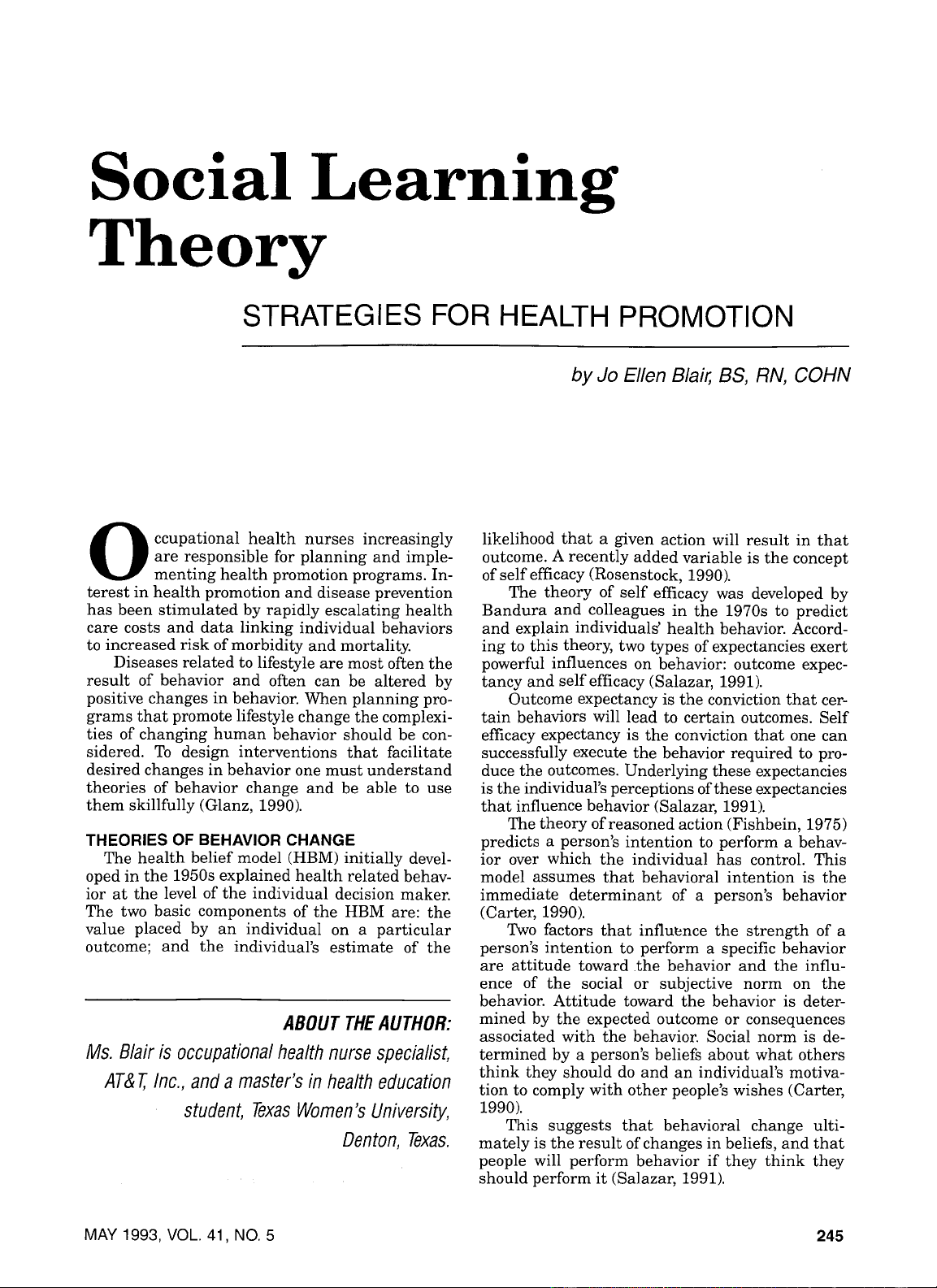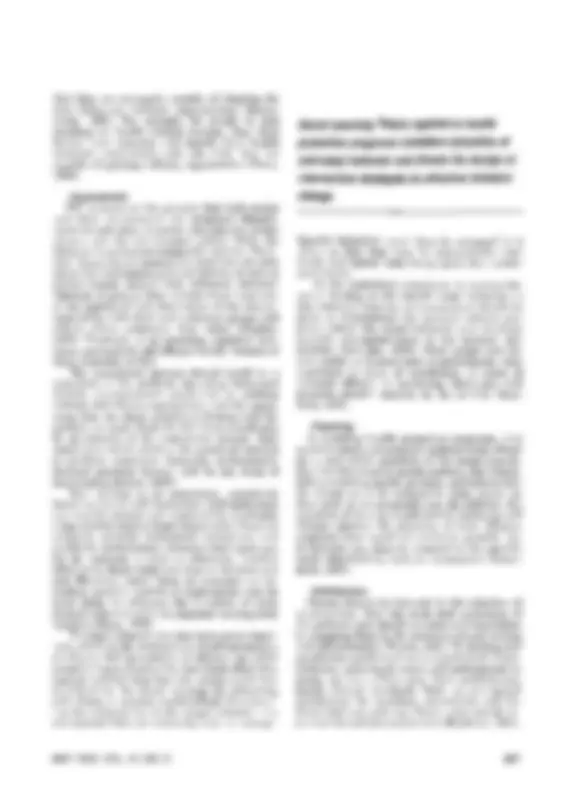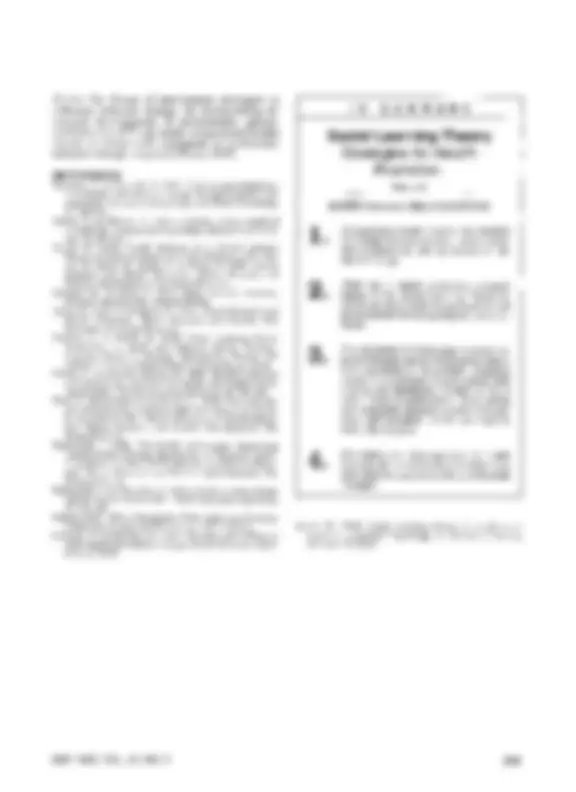





Study with the several resources on Docsity

Earn points by helping other students or get them with a premium plan


Prepare for your exams
Study with the several resources on Docsity

Earn points to download
Earn points by helping other students or get them with a premium plan
Community
Ask the community for help and clear up your study doubts
Discover the best universities in your country according to Docsity users
Free resources
Download our free guides on studying techniques, anxiety management strategies, and thesis advice from Docsity tutors
Social learning theory applied to health promotions programs to consider dynamic individual behavior.
Typology: Study notes
1 / 5

This page cannot be seen from the preview
Don't miss anything!




ccu pati onal health nurses increasingly are responsible for planning and imple- menting health promotion programs. In- terest in health promotion and disease prevention has been stimulated by rapidly escalating health care costs and data linking individual behaviors to increased risk of morbidity and mortality. Diseases related to lifestyle are most often the result of behavior and often can be altered by positive changes in behavior. When planning pro- grams that promote lifestyle change the complexi- ties of changing human behavior should be con- sidered. To design interventions that facilitate desired changes in behavior one must understand theories of behavior change and be able to use them skillfully (Glanz, 1990).
THEORIES OF BEHAVIOR CHANGE The health belief model (HBM) initially devel- oped in the 1950s explained health related behav- ior at the level of the individual decision maker. The two basic components of the HBM are: the value placed by an individual on a particular outcome; and the individual's estimate of the
ABOUT THE AUTHOR:
Ms. Blair is occupational health nurse specialist,
AT& T, tnc., and a master's in health education
student, Texas Women's University,
Denton, Texas.
likelihood that a given action will result in that outcome. A recently added variable is the concept of self efficacy (Rosenstock, 1990). The theory of self efficacy was developed by Bandura and colleagues in the 1970s to predict and explain individuals' health behavior. Accord- ing to this theory, two types of expectancies exert powerful influences on behavior: outcome expec- tancy and self efficacy (Salazar, 1991). Outcome expectancy is the conviction that cer- tain behaviors will lead to certain outcomes. Self efficacy expectancy is the conviction that one can successfully execute the behavior required to pro- duce the outcomes. Underlying these expectancies is the individual's perceptions of these expectancies that influence behavior (Salazar, 1991). The theory of reasoned action (Fishbein, 1975) predicts a person's intention to perform a behav- ior over which the individual has control. This model assumes that behavioral intention is the immediate determinant of a person's behavior (Carter, 1990). Two factors that influence the strength of a person's intention to perform a specific behavior are attitude toward the behavior and the influ- ence of the social or subjective norm on the behavior. Attitude toward the behavior is deter- mined by the expected outcome or consequences associated with the behavior. Social norm is de- termined by a person's beliefs about what others think they should do and an individual's motiva- tion to comply with other people's wishes (Carter, 1990). This suggests that behavioral change ulti- mately is the result of changes in beliefs, and that people will perform behavior if they think they should perform it (Salazar, 1991).
To design interventions that facilitate desired
changes in behavior one must understand
theories of behavior change and
be able to use them skillfully.
Bandura's (1981) social learning theory (SLT) is one of the most formally developed theories of health behavior. This theory addresses both the psychosocial dynamics underlying health behav- ior and the methods of promoting behavior change (Glanz, 1990). Stuart (1989) defined SLT as a method of describing, analyzing, and potentially influencing behavior. SLT is an educatoin in human relations that attempts to provide an environment in which effective learning may occur. This learning occurs in a systematic teach- ing-modeling program that emphasizes learning procedures derived from psychology and related behavioral sciences (Stuart, 1989).
Expectancies SLT holds that behavior is determined by ex- pectancies and incentives. Expectancies are the values, positive or negative, that a person places on a particular outcome. Expectancies influence behavior according to a hedonic principle: "if all things are equal a person will choose to perform an activity that maximizes a positive outcome or minimizes a negative outcome" (Perry, 1990). Therefore, by assessing a person's positive expectancies early in a project that is designed to promote changes in health behavior, motivators for that behavior can be identified (Perry, 1990). Expectancies may be divided into three types: expectancies about environmental cues, that is, how events are connected; expectancies about the consequences of one's own actions and how indi- vidual behavior is likely to influence outcomes, termed outcome expectation; and, expectancies about one's own competence to perform the behav- ior needed to influence outcomes, termed efficacy expectation or self efficacy (Rosenstock, 1988). Bandura believed that outcomes are deter- mined by one's own actions and can have any number of effects on self efficacy and behavior (Rosenstock, 1988). Bandura identified four sources of self efficacy information: performance attainments, vicarious experience, verbal persua- sion, and physiological state.
Performance accomplishments attained through experience are the most influential causes of efficacy expectations because they are based on personal mastery experiences. Succes- sive mastery over tasks required to engage in a behavior helps the person to develop and refine skills (Stretcher, 1986). Vicarious experience obtained through obser- vation of successful or unsuccessful performance of others is the next most influential source and may account for a major part oflearning through- out life. These events/people are referred to as "models" when they display a set of behaviors or stimulus array that illustrates a certain principle, rule, or response. For models to affect self efficacy positively, one must view the model as having overcome difficulties through determined effort rather than with ease. An achievement will enhance self efficacy only if it is attributed to one's own ability or skill and not to external or temporary factors, or chance. It is also important for the model to be similar to the observer with regard to such char- acteristics as age and sex. Modeled behaviors presented with clear, rewarding outcomes are more effective than modeling with unclear or unrewarded outcomes (Stretcher, 1986). Verbal persuasion is frequently used in health education to exhort clients to persevere in their efforts to change behavior. It may also influence outcome expectations or incentives. One's physio- logical state also provides information that can influence efficacy expectations. Physiological states may inform individuals that they are not capable of performing or main- taining a given action. To someone just beginning an exercise program, fatigue or mild aches and pains may be mistakenly interpreted as a sign of physical inefficacy. However, success in eliminat- ing negative effects may enhance one's self effi- cacy (Stretcher, 1986).
Incentives Incentive is defined as the value of a particular object or outcome. The outcome may be health status, physical appearance, approval of others, economic gain, or other consequences. Behavior is regulated by its consequences (reinforcements), but only as those consequences are interpreted and understood by the individual (Rosenstock, 1988). Individuals who value the perceived effects of changed lifestyle (incentives) will attempt to change if they believe that their current lifestyle poses threats to any personally valued outcomes, such as health or appearance (environmental cues); that particular behavioral changes will reduce those threats (outcome expectations); and,
AAOHNJOURNAL
Applications to Health Promotion Programs Several studies have used Bandura's SLT to provide the theoretical framework for health pro- motion programs (Parcel, 1988). The project "Go For Health" demonstrated the effective applica- tion of this approach for organizational change and classroom health education. Funded by the National Heart, Lung and Blood Institute (NHLBI), the 3 year study designed and evalu- ated a school based health promotion program to reduce cardiovascular disease risk factors in ele- mentary school children. The focus was on influ- encing diet and exercise behavior of third and fourth graders. Bandura's SLT provided the theoretical framework for the intervention, which focused on the interactions between environmental, cogni- tive, and behavioral factors. The intervention included: classroom instruction to influence cogni- tive factors to predispose students to being able to perform the behaviors; strategies to create a school environment that enabled students to prac- tice desired diet and exercise behavior; and, rein- forcement and support of the classroom messages (Parcel, 1988). This study concluded that SLT approaches were successfully employed with school age children in promoting healthful dietary practices by families and promoting both health- ful eating and exercise in schools (Parcel, 1988). In other experimental studies, manipulations of self efficacy have proven consistently powerful in initiating and maintaining change, supporting Bandura's assertion that efficacy expectations reflect a person's perceived, rather than actual, capabilities and that it is these perceptions and not one's true abilities that often influence behav- ior (Stretcher, 1986). For situations in which the health practice is believed to lead to desired consequences but the change is difficult to make, self efficacy considerations are probably para- mount. This is often the case among smokers, many of whom wish to quit, but feel unable to do so. According to Stretcher (1986), outcome expecta- tions and self efficacy are both important determi- nants of health behavior. Research studies em- ploying the concept of self efficacy in the general health practice areas of smoking, weight control, and exercise suggest that outcome expectations mediate initial motivation, while efficacy expecta- tions influence both implementation and mainte- nance processes. Many clinic based treatment programs for changing health behaviors adopt traditional methods of change employed for physical condi- tions. Relegating poor health practices to the status of "diseases" obligates persons wishing to change their lifestyles to seek outside treatment
from an expert. The treatment program then shifts the focus of responsibility for changing the desirable behavior from the client to the therapist and from the efficacy of the individual to the efficacy of the treatment. Programs that employ self help modes or minimal therapist contact in conjunction with self help may present behavior strategies in a way that removes the mysticism from change, better promotes personal coping skills, and enhances self efficacy. Studies consistently find a positive relationship between self efficacy, health behav- ior change, and maintenance. Strategies for en- hancing efficacy in practice should lead to more effective health promotion programs for a greater number of people (Stretcher, 1986). ' Solving the problems involved in modifying lifelong habits of eating, drinking, exercising, and smoking requires a good deal of confidence that one can, in fact, alter such lifestyles before suc- cessful intervention is possible. Thus, for behav- ioral change to succeed, people must have an incentive to take action, feel threatened by their current behavioral patterns, and believe that the behavior change will be beneficial. They must also consider themselves competent enough to imple- ment that change (Rosenstock, 1988). In the social learning model the occupational health nurse tries to motivate employees to de- velop self regulated behavior. Behavioral stan- dards are the key to self regulatory behavior and are best established by instruction, experiencing consequences growing out of behavior, and ob- serving models engaging in self evaluative behav- ior (Brown, 1987). The occupational health nurse can enhance motivation by: cueing employees to the possible positive outcomes of behavior change; assisting them to set goals that correspond to their own standards; and, developing situations that will enhance employee confidence that they can perform the skills needed for behavior change (Brown, 1987). Bandura noted that warm, nurturant individ- uals characterized by open, nondefensive commu- nication engender imitative behavior, thus en- hancing the educational process (Brown, 1987). Another variable under the control of the occupa- tional health nurse that appears to influence behavior is competence (Bandura, 1981). Thus, it is incumbent on nurses to communicate their competence when establishing an effective rela- tionship. This can be accomplished by de- monstrating a knowledge of the employee's envi- ronment and by modeling practices that can readily be adapted to both the employee and the environment (Brown, 1987). SLT applied to health promotion programs considers dynamics of individual behavior and
AAOHNJOURNAL
AAORN Journa/1993; 41 (5):245·249.
Stuart, R. (1989). Social learning theory: A vanishing or expanding presence? Psychology, A Journal of Human Behavior, 26, 36-47.
Social Learning Theory
Strategies for Health
Promotion.
directs the design of intervention strategies to influence behavior change. By incorporating re- ciprocal determinants of environment, people, and behavior, SLT can enable occupational health nurses to design and implement comprehensive behavior change programs (Perry, 1990).
REFERENCES Bandura, A., & Schrenk, D. (1981). Cultivating competence, self efficacy, and intrinsic interest through proximal self- motivation. Journal of Personality and Social Psychology, 41,586-597. Brown, D., & Schulte, A. (1987). A social learning model of consultation. Professional Psychology: Research and Prac- tice, 18, 283-287. Carter, W. (1990). Health behavior as a rational process: Theory of reasoned action and multi-attribute utility the- ory. In: Glanz, K., Lewis, F., & Rimer, B. (Eds.) Health Behavior and Health Education: Theory Research and Practice. San Francisco, CA: Jossey-Bass, Inc. Fishbein, M., & Ajzen, 1. (1975). Belief, Attitude, Intention, Behauior. Reading, MA: Addison-Wesley. Glanz, K., Lewis, F., & Rimer, B. (1990). Health Behavior and Health Education. Theory Research and Practice. San Francisco, CA: Jossey-Bass, Inc. Hughes, 0., & Ravell, M. (1989). Social learning theory: Application to adult and pediatric clients. Practice- Oriented Theory in Nursing (Monograph). Denton, TX: College of Nursing, Texas Women's University, pp. 24-28. Parcel, G., & Simmons-Morton, B. (1988). Health promotion and integrating organizational change and student learn- ing strategies. Health Education Quarterly, 15, 435-450. Perry, P., Baranowski, T., & Parcel, G. (1990). How individu- als, environments, and health behavior interact. In: Glanz, K., & Lewis, F. (Eds.) Health Behavior and Health Educa· tion: Theory, Research, and Practice. San Francisco, CA: Jossey-Bass, Inc. Rosenstock, 1. (1990). The health belief model: Explaining health behavior through expectancies. In: Glanz, K., Lewis, F., & Rimer, B. (Eds.) Health Behavior and Health Educa- tion: Theory Research and Practice. San Francisco, CA: Jossey-Bass, Inc. Rosenstock, 1., & Stretcher, V. (1988). Social learning theory and the health belief model. Health Education Quarterly, 15,175-183. Salazar, M.K. (1991). Comparison of four behavioral theories: A literature review. AAOHN Journal, 39(3),128-135.
achieving health behavior change. Health Education Quar- terly, 13, 73-91.
1.
2.
3.
4.
IN SUMMARY
Blair, J.E.
Occupational health nurses can facilitate the design of more effective health promo- tion programs by utilizing theories of be- havior change.
Planning a health promotion program based on the Social Learning Theory in- cludes an assessment of personal as well as environmental factors that influence be- havior.
The motivation of employees to make be- havior changes can be enhanced by raising their awareness of the problem, engaging clients in the process of goal setting, and making self-satisfaction conditional on a certain level of performance. Goal setting with attainable subgoals creates and sus- tains self-motivation, which can lead to larger, future goals.
Interpreting the consequences of health behavior can be an incentive for individuals who value the perceived effects of lifestyle changes.